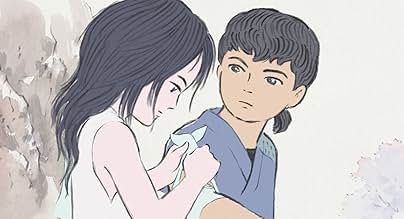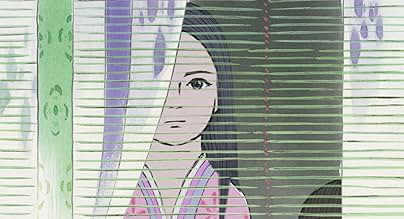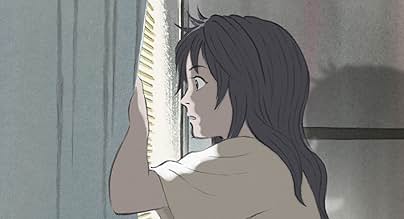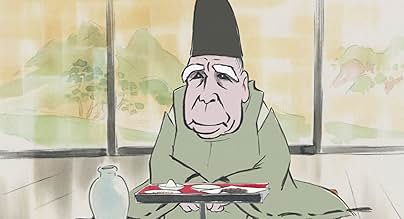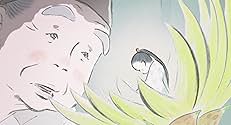Kaguya é uma bela jovem cobiçada por cinco nobres. Para tentar evitar se casar com um estranho que não ama, ela envia os pretendentes em tarefas aparentemente impossíveis. Mas ela terá que e... Ler tudoKaguya é uma bela jovem cobiçada por cinco nobres. Para tentar evitar se casar com um estranho que não ama, ela envia os pretendentes em tarefas aparentemente impossíveis. Mas ela terá que enfrentar seu destino e punição por suas escolhas.Kaguya é uma bela jovem cobiçada por cinco nobres. Para tentar evitar se casar com um estranho que não ama, ela envia os pretendentes em tarefas aparentemente impossíveis. Mas ela terá que enfrentar seu destino e punição por suas escolhas.
- Direção
- Roteiristas
- Artistas
- Indicado a 1 Oscar
- 13 vitórias e 38 indicações no total
- The Princess Kaguya
- (English version)
- (narração)
- The Bamboo Cutter
- (English version)
- (narração)
- The Bamboo Cutter's Wife
- (English version)
- (narração)
- …
- Prince Ishitsukuri
- (English version)
- (narração)
- Kaguya hime
- (narração)
- …
- Sutemaru
- (narração)
- Okina
- (narração)
- Ôna
- (narração)
- …
- Sagami
- (narração)
- Menowarawa
- (narração)
- Inbe no akita
- (narração)
- Ishitsukuri no miko
- (narração)
- Abe no udaijin
- (narração)
- Ôtomo no dainagon
- (narração)
- Mikado
- (narração)
- Kuramochi no miko
- (narração)
- Kaguya hime (child)
- (narração)
- Voice Appearance
- (narração)
Avaliações em destaque
I believe that "Princess Kaguya" is the best Ghibli film in the past 10 years because of the beautiful hand-drawn animation and touching story.
Japanese audience and critics are also very positive for this film, compared to other Ghilbi films.
Hayao Miyazaki is a genius but his recent films are always controversial since "Haul's Moving Castle".
One of the reason is that he relies on his imagination and makes light of a script. That's why quite a few people can't fully understand his recent films and sometimes blame them. ("The Wind Rises" was a tragedy in this meaning.)
Isao Takahata, the director of "Princess Kaguya", is a very good director known for "The Grave of Firefly" but not so active since "My neighbor the Yamada".
His philosophy is very different from that of Hayao Miyazaki. Isao Takahata thinks the scenario is very important and he prefers realism to fantasy.
"Princess Kaguya" is based on the Japanese oldest folklore "The Tale of the Bamboo Cutter". But Isao Takahata transforms it into a universal humanistic story by describing Princess Kaguya as a realistic girl.
This film contains many fantastic scenes and they play as good eye candies. But the brilliantly illustrated life and emotions of the heroine is the most important part in this film. And that's what the director wants us to try to sympathize.
The beautiful and artistic style of this animation is suitable for this theme. Because this apparently unfinished animation gives us the room to imagine by ourselves.
Isao Takahata says, "The animations tend to deprive children of their own imagination by pushing them someone else's fantasy. We have to make another animation which let them imagine by themselves".
I can't wait to see the responses from the worldwide audience! Hope you will like this film too!
The film is beautiful. The animation is simple yet exquisite, reminiscent of old Japanese watercolours. Special kudos go to Joe Hisaishi for his superb soundtrack - the final scene and its music left me almost in tears.
The only problems lie in the sometimes slow development of the plot and a few loose ends. There are also tiny deviations from the original story, but I felt that it was as true to it as possible. All in all a beautifully drawn, beautifully crafted movie, solid voice acting (for a Japanese movie at least) and, again, the beautiful music. Excellent job, Ghibli.
Hats down to Mr. Takahata as well.
The Tale of the Princess Kaguya tells the story of its titular character who was found in a bamboo shoot by a bamboo cutter who, believing her to be a divine presence, brings her home to his wife. Although this mysterious tiny girl grows rapidly into a young lady, dazzling all who encounters her, she eventually is left with no alternative but to confront her own fate.
Co-written & directed by Isao Takahata (best known for Grave of the Fireflies), this tale is crafted with precision care & elegance plus how all of it is animated brings an artistic vibe of its own. The use of colour palette, sketch-like animation & minimalist approach leaves a lasting impression, the voice performances are spot-on while Joe Hisaishi's score nicely compliments the whole narrative.
The Tale of the Princess Kaguya also covers the various restraints women find themselves in every facet of life, no matter what society they happen to be part of, and exposes that without preaching. However, its 137 minutes of runtime feels a tad too long, the final act is stretched, and although its creativity is undeniably impressive, the whole story kind of lacks that immersive element, much like Takahata's earlier works.
On an overall scale, The Tale of the Princess Kaguya brims with some truly astonishing images and is another winning marvel from the acclaimed studio. It's aesthetically pleasing, artistically fulfilling & emotionally gripping and there are going to be many who will have nothing but endless praise for the manner in which this ancient Japanese folklore is illustrated on the film canvas. As for me, I do admire a number of things about Takahata's latest but don't feel any love for it. Still, I've no qualms in recommending it to anyone for it is worthy of a broader audience.
It's about an elder bamboo cutter named Okina who discovers a young, tiny girl in a bamboo shoot and decides to adopt her as his own along with his loving wife Ona. As years progress, the tiny girl begins to grow rapidly to normal size like the other children of their village, eventually having to leave since her adoptive parents decide to have her raised among the nobles. From there, she is given the name "Princess Kaguya" and things become further complicated when so much is offered to her so suddenly.
When comparing this movie to past Studio Ghibli efforts, it's obvious that the animation style is nothing like its preceding films. And with studio founder Hayao Miyazaki having stepped down and no involvement with this current project, I have to say it's a drastic, yet vibrant change in what Studio Ghibli is widely known for. I loved the story and it had an ending that was rather heartwarming and enough to tug anyone's heartstrings. With the English dub voice of Kaguya done gracefully by Chloe Grace-Moretz (Let Me In, Carrie, If I Stay), she actually stands out well as the title character, like it wasn't forced.
The animation technique was rather intricate, but it was reminiscent of an old Japanese art painting I've once studied about in Art History classes at my local college. American animation studios have believed traditional 2-D to be a dying art form in the film industry these days, but I can tell Japan does not acknowledge it in that way at all, whether it's TV or film. The concept I started believing for the entire film felt like "a timeless painting" and it's quite a stroke of genius, in my opinion.
The music and underscore of Joe Hisaishi has left me engaged that it flows evenly well with the scenes as they play out. But most notably, director Isao Takahata really stepped up following his involvements with titles like "Kiki's Delivery Service," "My Neighbor The Yamadas," and even the touching "Grave of the Fireflies." This entire movie has earned its rightful place in the Studio Ghibli library. This is another example of a Ghibli film where you don't have to be an avid Japanese Anime fan to enjoy it, what matters is that such themes existed in various genres, not just in one medium or one genre alone.
For the most part, the story you see in the film is the old tale. One day, a poor woodcutter slices into a stalk of bamboo and finds a beautiful thumb-size child. Since he and his wife are childless and have always wanted one, they are overjoyed with the discovery and raise the child. However, the same fortune that brought them the baby also rewarded them with gold when the woodcutter chopped additional bamboo. And, oddly, the child grows to normal size and becomes a lady in practically no time at all. Soon they are rich and able to give their girl the life of a princess and she's taught all manners and customs that a proper lady would need. However, it's obvious that young Princess Kaguya isn't happy in this life, as courtier after courtier come for her hand and she simply isn't interested. So, she gives them impossible tasks to complete before she'd agree to marry any of them. When they all fail, the Emperor himself comes to court her but she rebuffs him--mostly because she knows her time on Earth is drawing to a close. Where all this goes next, you'll find out if you watch the movie.
The animation for this movie is quite lovely--with a nice look that appears as if the film was made with colored pencils and watercolors. While it's more minimalistic than you'd usually find in a Ghibli film, it looks very appropriate to the Medieval Japanese period. In fact, the look of the film is the best thing about the movie. The story, as you probably noticed above, is odd--especially to non-Japanese audiences. The ending, is even odder, by the way. But the film still could have worked despite the unusual story. However, I found the pacing to be too slow and I noticed my attention waning from time to time. Not surprisingly, it's the longest film released by Ghibli to date. Had they trimmed about 15 to 20 minutes and removed the plot involving the poor boyfriend (which was not in the original story), I think the film would have worked better for me. Worth seeing for a very patient audience who is looking for something very different--otherwise a strange sort of picture that probably would offer little appeal to kids and folks wanting something light and Disney-like.
By the way, although I was not bowled over by this film, it has been nominated for the Academy Award for Best Animated Feature. My vote is for "The Box Trolls"...a film which managed to combine both artistry and an excellent original story.
Você sabia?
- CuriosidadesIn several scenes in the movie, Kaguma-Hime, Lady Sagami and Ona can be seen wearing multi-layered kimonos called Junihitoe. Both the number of layers and the coloring of the layers worn would be dictated by the occasion, status, and season the wearer is in.
- Erros de gravaçãoWhile the baby princess crawls to the cutter she tosses a piece of bamboo to the edge of the floor mat. In the reverse shot as she crawls back, it is missing.
- Citações
The Princess Kaguya: [singing] Go round, come round, come round... Come round, oh distant time. Come round, call back my heart. Come round, call back my heart. Birds, bugs, beasts, grass, trees, flowers. Teach me how to feel. If I hear that you pine for me, I will return to you.
- ConexõesFeatured in Troldspejlet: Episode #50.12 (2014)
Principais escolhas
- How long is The Tale of The Princess Kaguya?Fornecido pela Alexa
Detalhes
- Data de lançamento
- País de origem
- Centrais de atendimento oficiais
- Idioma
- Também conhecido como
- El cuento de la princesa Kaguya
- Empresas de produção
- Consulte mais créditos da empresa na IMDbPro
Bilheteria
- Orçamento
- JP¥ 5.000.000.000 (estimativa)
- Faturamento bruto nos EUA e Canadá
- US$ 974.913
- Fim de semana de estreia nos EUA e Canadá
- US$ 54.915
- 19 de out. de 2014
- Faturamento bruto mundial
- US$ 24.751.400
- Tempo de duração2 horas 17 minutos
- Cor
- Mixagem de som
- Proporção
- 1.85 : 1







